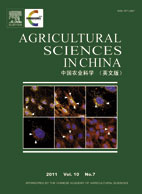|
|
Mapping of QTL Associated with Drought Tolerance in a Semi-Automobile Rain Shelter in Maize (Zea mays L.)
ZHU Jing-jing*, WANG Xiao-peng*, SUN Cui-xia, ZHU Xiu-miao, LI Meng, ZHANG Guo-dong, TIAN Yanchen, WANG Ze-li
2011, 10(7):
987-996.
DOI: 10.1016/S1671-2927(11)60085-0
Drought is a major constraint in maize production worldwide. We studied quantitative trait loci (QTL) underlying droughttolerance for maize plants grown in two different environments. Traits investigated included ASI, plant height, grain yield,ear height, and ear setting. A genetic linkage map was constructed with 120 simple sequence repeat (SSR) markers basedon an F2 population derived from a cross between D5 (resistant parent) and 7924 (susceptible parent). Correlation andheritability were calculated. QTLs of these traits were identified by composite interval mapping combined with a linkagemap covering 1 790.3 cM. The markers were arranged in ten linkage groups. QTL mapping was made of the mean traitperformance of the 180 F2:3 population. The results showed five, five, six, four, and five QTLs for ASI, plant height, grainyield, ear height, and ear setting under full irrigation condition, respectively, and four, seven, six, four, and four QTLs forASI, plant height, grain yield, ear height, and ear setting under severe late stress conditions, respectively. Especially thefour QTLs detected for five traits in 2008 and 2009. The universal QTLs information generated in this study will aid inundertaking an integrated breeding strategy for further genetic studies in drought tolerance improvement in maize.
|
